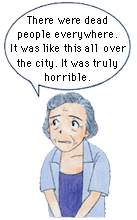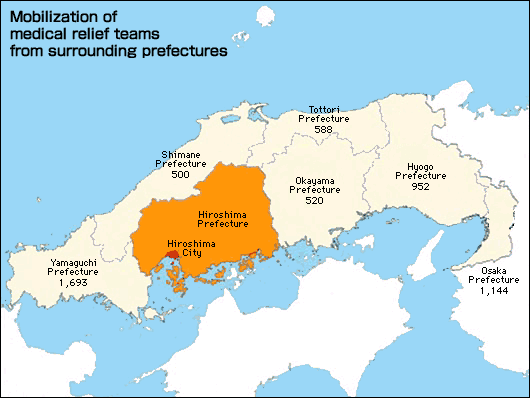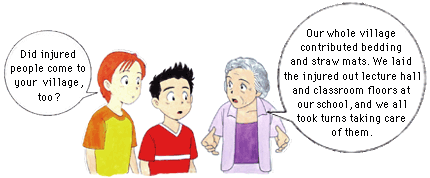
| Full-scale Relief Activities |
|
By the 7th, the day after the bombing,
the relief activities that had begun in utter confusion finally achieved some degree of organization. On the evening of the 6th, the newly established Prefectural Air Defense Headquarters began issuing concrete requests to police departments around the prefecture and in nearby prefectures for medical supplies,food and other supplies. In response, relief teams poured in from far and wide to help transport the injured, transport relief supplies, and join in other relief activities. On the morning of the 7th, military, prefectural and city authorities and private citizens held a joint meeting to plan the restoration of the city. The entire community decided to cooperate in relief activities. |
| 31 Establishing the relief system Around November 1945 / Hiroshima East Police Station Shimo-yanagi-cho (now Kanayama-cho) (1,210m from the hypocenter) On August 7, the Prefectural Air Defense Headquarters moved from Tamonin Temple on Hijiyama Hill to the East Police Station near the center of the city. At 10 a.m. that morning, at the joint public-private meeting held at the Second General Army Headquarters, relief for survivors and restoration of the city were discussed, and it was decided that the military would direct the relief effort. The commander of the Akatsuki Corps that had begun relief activities immediately after the bombing was appointed commander of Hiroshima Security Regiment Headquarters. They divided the city into four areas-east, west, center, and north-and began relief activities in each of those areas. Medical relief and civil defense teams arriving from around Hiroshima and other prefectures first gathered at the East Police Station and were assigned to relief areas under orders from the Prefectural Air Defense Headquarters. |
 |
 |
32 Relief supplies delivered to Hiroshima Relief supplies came to Hiroshima from everywhere. The main items were rice, wheat, and other food, but cooking utensils, straw sandals and other necessities were also delivered. After Japan surrendered on August 15, the city government took possession of the large quantities of clothing, shoes, and blankets that the military had in storage and distributed them to survivors. (1) Rice : about 916 bags (2) Salt : 83 bags (3) Soy Sauce : 33701 liters (4) Hardtack : 3300 pieces (5) Wheat : 4 bags (6) Canned Goods : 9214 boxes (7) Cooking oil : 262 kg (8) Vegetables : 10173 kg (9) Firewood : 24260 bundles (10) Pickled Plums : 28653 kg (11) Miso : 11756 kg |
 |
 |
| 33 Chart of ration of rice balls for survivors August 6, 1945 |
34 Relief supplies delivered to the Prefectural Air Defense Headquarters August 8, 1945 / Hiroshima East Police Station, Shimo-yanagi-cho (now Kanayama-cho) (1,210m from the hypocenter) Relief supplies were loaded onto trucks and trains and sent to the East Police Station or directly to relief stations. Rationing stations established during the war had been destroyed, so the police and civil defense teams distributed the supplies. |
 |
| 35 Mobilization of prefectural civil defense teams Beginning the day of the bombing, civil defense teams from many parts of the prefecture entered the city for relief activities. By the end of August, their number had reached 21,000*. Supervised by the police, civil defense team members removed rubble, transported the injured, and handled and cremated corpses. *This is the recorded number of relief workers. The actual number is thought to be higher. |
 |
 |
| 36 Cremating the dead August 8, 1945 / The streetcar track in kamiya-cho (300m from the hypocenter) The burnt ruins were filled with countless unidentified corpses. These were gathered and taken to riversides, schoolyards, and other open areas for cremation. Around the city, day after day smoke from cremation fires billowed into the sky. |
37 Stretcher |


 |
 |
| 38 Arrival of medical relief teams from around the prefecture and beyond By two months after the bombing and the start of operations for prefectural relief teams of doctors, nurses, public health nurses and other medical personnel, more than 21,000* individuals had joined the relief effort. The first to arrive from outside the prefecture were from neighboring prefectures---Okayama, Shimane, and Yamaguchi ---but relief teams also came from as far away as Hyogo and Osaka. In addition, army and navy teams and even students from girls schools around the prefecture worked at relief stations and hospitals in or near the city. *This is the recorded number of relief workers. The actual number is thought to be higher. |
 |
 |
| 39 Medical relief teams that provided treatment August 7, 1945 / In front of the Hiroshima Credit Union Head Office Yokogawa-cho 3-chome (1,700m from the hypocenter) Medical relief teams comprised a number of lay volunteers revolving around a doctor and a nurse. They entered the city planning to stay several days. On arrival in Hiroshima, they first reported to the Prefectural Air Defense Headquarters at the East Police Station. There they were assigned to one of the many relief stations set up around the city. |
40 Emergency relief station on a riverbank August 8, 1945 / Moto-machi (1,100m from the hypocenter) |
 |
41 Relief activity locations in Hiroshima City On the day of the bombing, injured people thronged to the ends of bridges and riverbanks. Medical relief teams were dispatched to such places and often turned them into relief stations. Hiroshima Prefecture has confirmed that 53 relief stations were set up in or around the city on and after August 6. Records show that relief activities took place in many more places. |
 |
 |
| 42 Relief station in a bamboo grove August 1945 / Uchikoshi-cho (2,000m from the hypocenter) |
43 Relief station on a streetcar track August 9 to 14, 1945 / Funairi-naka-machi (1,300m from the hypocenter) |
 |
| 44 Locations to which the injured were transported beyond the city Based on Hiroshima A-bomb Medical Care History and War History of Hiroshima Prefecture Relief stations were quickly established in Aki, Saeki, Asa County and other areas neighboring Hiroshima City. Those who could not be accommodated in or near the city were assigned and transported to army hospitals or relief stations in cities, towns, and villages even further away. Many were carried considerable distances, as far as neighboring Shimane and Yamaguchi prefectures. *These are the recorded numbers of persons helped and relief stations. The actual numbers are thought to be higher. |

 |
45 A train filled with the injured August 8, 1945 / Shiwaguchi Station No trains could leave from Hiroshima Station; the closest operating stations were in Yano or Kaitaichi. Many survivors left the city from those stations. Military ships and trucks were also used to transport the injured. The horrifying condition of the wounded, inconceivable with conventional bombing, shocked the people receiving them in outlying communities. Whole communities cooperated to offer whatever they could. |
| Helping
Victims in the Burnt Plain -- Relief Activities with neither Medicine nor Food to Offer -- Preparing for Air Raids Relief Activities amid the Turmoil Full-scale Relief Activities Conditions in Relief Stations and the Suffering of the People(1) Conditions in Relief Stations and the Suffering of the People(2) Relief Activities by the Akatsuki Corps on August 6 Conclusion Individuals and Group Contributors to This Exhibition Return to TOP |